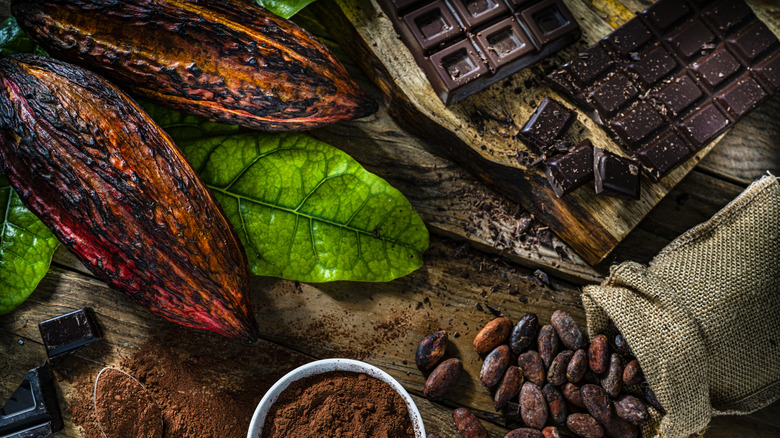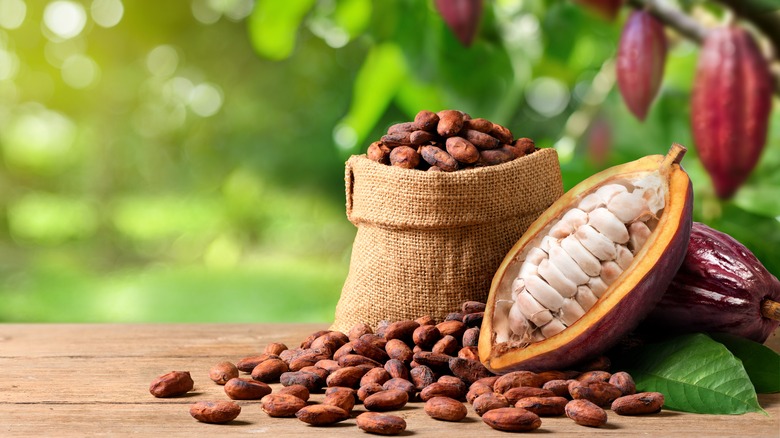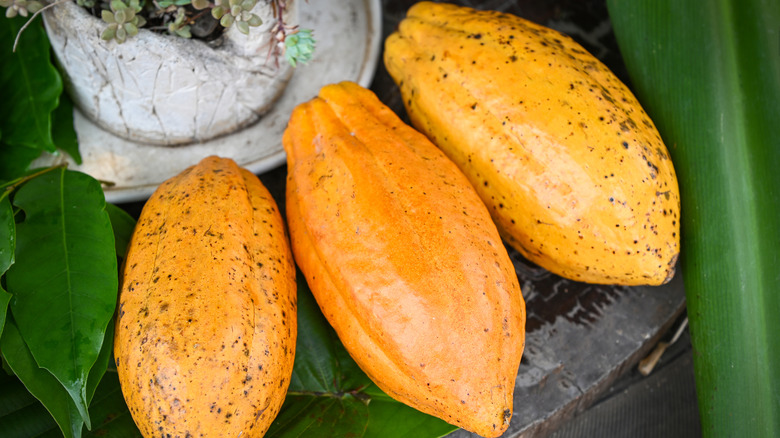The 3 Types Of Cacao Beans That Make Up The World's Chocolate
Chocolate is one of those universal constants in global cuisine: No matter where you go, it's harder to find people who don't enjoy it than those who do. But chocolate is also one of those ingredients where you probably don't even know where it comes from. You're probably aware it doesn't grow in the ground in convenient Hershey's block form, but you might only know chocolate's base form as "some kind of fruit or something."
This would be the cacao fruit. Despite what you might think, cacao can actually be eaten raw. The process of turning it into either chocolate or cocoa (different from powdered cacao) is much more longwinded and involves heavy fermentation, but it eventually results in the candy we all know and love. Only ... there's not one type of cacao fruit; there are actually three. The forastero, trinitario, and criollo varieties of cacao all have their strengths and weaknesses — although most of the chocolate you've had in your life is probably forastero.
Forastero cacao is the most common, and also considered the worst
All three of the cacao cultivars have Spanish names, and that's because of the Europeans who encountered them first. Spanish colonizers in Central America and Mexico first discovered criollo, upon which they gave it its name, meaning "native" (ironic, since even criollo wasn't native to that area, having originated in the Amazon river basin). Forastero ("foreign") became the name for any cacao the Spanish settlers found anywhere else. Trinitario, meanwhile, was created later (by accident) as a hybrid of criollo and a forastero cultivar.
The thing about different strains of the same edible plant is that the one that winds up with market dominance isn't necessarily the one that tastes the best. Such is the case with cacao because forastero, seen as the lowest quality of the three from a taste perspective, forms the base of most chocolate consumed all around the world. Roughly 70% of the world's chocolate comes from forastero cacao, and it's not because of its taste: Forastero is widely regarded to be the least appealing in terms of flavor. It's also the hardiest, though, with the greatest crop yields. That combo explains why it predominates: Mass production in chocolate means going for the most cost-efficient option, and that's forastero.
Criollo and trinitario each have their strengths
Criollo is the rarest of the three cacao beans due to its weaknesses as a plant and the expense of growing it. Only 10% of the world's cacao comes from criollo cultivars due to the plant being susceptible to disease and producing a significantly lower crop yield than forastero. However, it also has significantly less bitterness and acidity than its cousin. These factors combine to make criollo the variety used in the highest-end chocolate.
Trinitario (of Trinidadian origin, hence the name) only came into existence by accident. Most criollo cacao in Trinidad was wiped out in the 18th century, either by a plant illness or a devastating weather event. Whatever caused it, the Spanish colonial authorities brought in forastero trees to replenish cacao crops. These trees then cross-pollinated with the few criollo trees left on the island, creating trinitario, a halfway strain with more hardiness than criollo but more flavorful than forastero. It currently makes up around 20% of the world's cacao crops.
In reality, there are a ton of different crossbreeds between the three cacao beans, and it's not necessarily true that any individual criollo-based chocolate will taste better than a forastero one. But there's a reason why mass-produced chocolate bars don't generally hold a candle to artisanal ones, and its cacao base is the differentiator.


